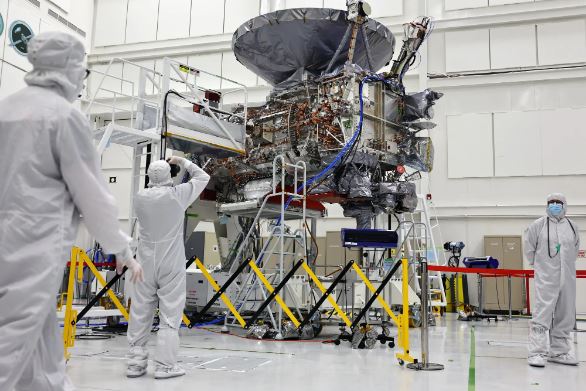NASA announced on Thursday it is examining the durability of transistors on the $5 billion Europa Clipper spacecraft, destined for Jupiter’s moon, Europa. Concerns have emerged about the spacecraft’s ability to withstand the intense radiation around Jupiter, potentially leading to a significant delay in the mission.
The Europa Clipper mission, classified as a “flagship” by NASA, is among the agency’s most scientifically significant endeavors. If the spacecraft launches in October as planned, it might not achieve its scientific objective of determining Europa’s habitability due to the vulnerability of its transistors to Jupiter’s severe radiation.
Transistors, essential components of computer chips and electronics, need to resist the powerful radiation in the Jovian system. The radiation in space, caused by cosmic rays and solar eruptions, poses challenges for every spacecraft. However, Europa orbits within the particularly hazardous Jovian radiation belt, which is over 50 times more radioactive than Earth’s environment.
NASA’s engineers are concerned about two types of radiation dosages: the total ionizing dose, which accumulates over time, and the flux dose, which involves radiation surges. These can corrupt data, cause short circuits, disrupt voltage levels, and damage electronics. Engineers typically mitigate these effects by using shielding, creating “radiation vaults” for critical technologies, or employing radiation-hardened parts like the MOSFET chips currently under scrutiny.
On May 3, NASA’s Jet Propulsion Laboratory (JPL) learned from a “non-NASA customer” that these radiation-resistant MOSFET chips failed at radiation levels significantly lower than required. Jordan Evans, the Europa Clipper project manager at JPL, highlighted this issue at a Space Studies Board meeting, noting the ongoing effort to address the spacecraft’s radiation vulnerability.
Shannon Fitzpatrick, head of flight programs for NASA’s Planetary Science Division, stated that engineers are still working to resolve the issue. The MOSFET chips in question, manufactured by Infineon Technologies, are also used in military spacecraft. An Infineon spokesperson emphasized the company’s stringent quality and performance standards.
Past spacecraft visiting Jupiter have contended with its radiation, but the Europa Clipper mission requires close proximity to Europa’s surface to study its ocean, ice, and interior. Engineers designed a flight path to minimize radiation exposure by orbiting Jupiter and making close flybys of Europa, aiming to capture detailed images of 90% of its surface over four years.
The spacecraft’s mission is to determine Europa’s potential habitability. Europa, roughly the size of Earth’s moon, has an ice-covered ocean with more liquid saltwater than Earth. This ocean, interacting with the seafloor and organic material from comets and asteroids, could potentially sustain life forms through radiation-driven oxidation.
A “tiger team” at JPL is currently investigating the chip issue and will share preliminary results with mission scientists and engineers. They are assessing how long the spacecraft could survive with the current chips. Depending on their findings, they may recommend a different launch plan or a delay.
If engineers can’t confirm the spacecraft’s survival as designed, NASA might have to reconsider the mission’s plan or change its launch schedule. With over five years to reach Jupiter, engineers might find ways to salvage some scientific objectives, possibly through alternative trajectories avoiding the worst radiation.
Alternatively, NASA could delay the launch to replace the flawed chips. This process, while straightforward, involves disassembling the spacecraft and could take several months to a year. If suitable chips are scarce, engineers might need to use substitutes, requiring a complete re-evaluation of the spacecraft, potentially delaying the mission by years.
Despite any delays, ensuring the spacecraft’s capability to fully explore Europa’s potential for life is crucial, fulfilling the dreams of a generation of planetary scientists.

